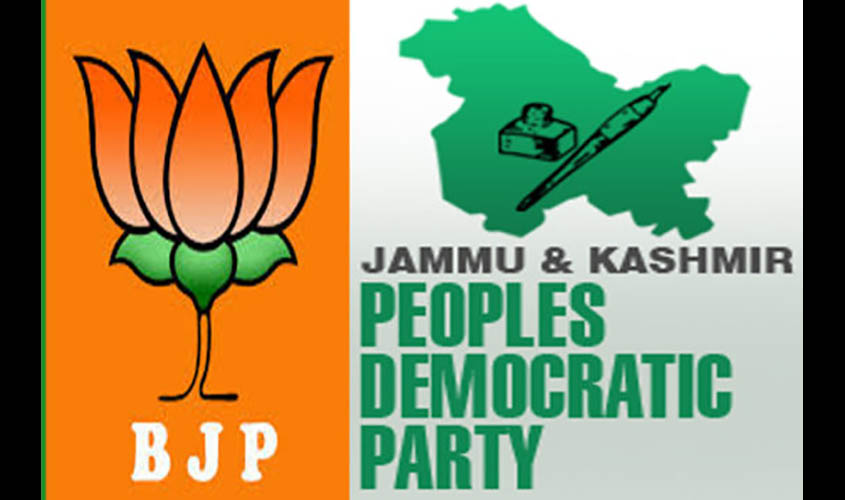The Bharatiya Janata Party’s well-calibrated decision to pull out from its alliance with the People’s Democratic Party (PDP) in Jammu and Kashmir leading to the imposition of Governor’s Rule in the state is part of a larger saffron strategy in the strife ridden region.
In fact, the alliance came into existence during the lifetime of Mufti Mohammad Sayeed after the two largest parties—the PDP which enjoyed the supremacy in Kashmir with 28 seats and the BJP which emerged as the dominant force from Jammu with 25 seats—joined hands in spite of their inherent ideological contradictions. The mandate in the 2014 Assembly polls was against the ruling National Conference (15 seats), and the Congress managed to salvage some self-respect by obtaining 12 seats with the Independents and smaller parties accounting for the remaining seven in the 87-member House.
Mufti’s sudden demise within a year of the formation of this alliance resulted in the baton being passed on to his daughter, and political heir, Mehbooba Mufti, who clearly lacked his experience and incisiveness to keep the BJP in check, while simultaneously ensuring that the PDP’s popularity in the Valley did not diminish. It was visible to any observer that the coalition government was unable to deliver on its promises and instead of providing good governance the state witnessed a heightened rise in incidents of violence and terrorism.
The BJP was under tremendous pressure from its constituents and supporters to assert itself in order to consolidate its position—at least in the Jammu region—which for the first time, since Independence, received prominence that had earlier been confined only to the more privileged Kashmir Valley. It was only a matter of time that this alliance would have collapsed; there were several occasions when the PDP was at its wit’s end, but unquestioningly continued with the power sharing arrangement.
It, therefore is, immensely critical to comprehend why in the first place the BJP forged its relationship with the PDP. The Sangh Parivar had three principle objectives that led to this alliance, which its detractors described as unholy. The BJP was eager that during Narendra Modi’s tenure as Prime Minister, it should be able to share power in Srinagar in the only Muslim dominated state in the country. It was a historic decision to tie up with the PDP and placed the BJP as a shareholder in the state government so that it could help Jammu regain its distinguished and rightful status that had been overshadowed by political players from the Valley.
The more important objective was to contain the authority of the PDP, which had its origin in the separatist movement in the state. There were PDP leaders who shared superlative chemistry with several components of the Hurriyat, as also with disruptive elements from across the border. However, the nearly four-year courtship with the BJP, where Mehbooba Mufti was compelled to make several compromises, has virtually destroyed the credibility of the PDP. After the fall of her government, Mehbooba and her party activists would find it exceedingly laborious to explain their association with the saffron brigade, which is an out and out pro-Indian combination of supporters of the Sangh Parivar, and opposed to any kind of pro-Pakistan sentiment which exists in vast areas of the Valley. In other words, the coalition with the BJP has left the PDP in its most vulnerable condition, and it would be a monumental task to politically resuscitate itself. For the time being, it has been rendered politically irrelevant and unless it is able to regain support from the forces that contributed to its formation, it would have to pass through turbulent times.
Finally, the BJP has succeeded in isolating the Kashmir Valley while also highlighting the needs and demands of both Jammu and Ladakh. The Rashtriya Swayamsevak Sangh (RSS) has, in the past, passionately spoken about demarcating the state into three distinct regions so as to accelerate uniform development activity. Having achieved its immediate goals, the Sangh is likely to focus its attention on proportionately important matters such as restoring the rule of law in the state.
There has been widespread speculation that the Centre would appoint a new Governor to replace the highly efficient incumbent, N.N. Vohra, who has held the position since the past ten years. This would appear unlikely even though some leaders in the BJP had made a strong case for Dineshwar Sharma, the Centre’s interlocutor, to be his successor. Firstly, if there had to be a change in the governorship, it ideally would have been done before the BJP pulled out its support. Secondly, to have a new Governor when the Amarnath Yatra was to commence would create perilous insecurity as the state machinery would be better served in the experienced hands of Vohra. In any case, it is the government’s call.
It is noticeably indicative that the Centre no longer would sit still if Pakistan attempts to gain an upper hand in the Kashmir Valley. It is prepared to take the enemy head-on, and as a consequence not hesitate in initiating any military action if the need arose. Kashmir, for several years now, has been on the boil and the Modi government appears determined to use the opportunity arising out of the disturbed status to send unambiguous signals to the rest of the country that it would not take things lying down but go in for a no-nonsense approach to assert itself. Between Us.

